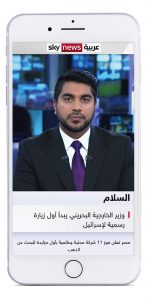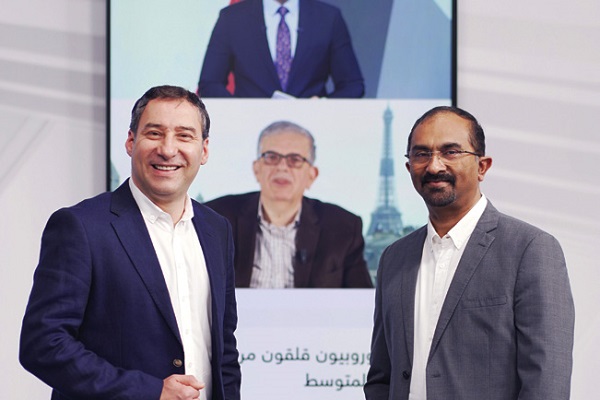With research and surveys showing that more than half of all video content is now consumed on mobile devices such as smartphones and tablets, Abu Dhabi-based broadcaster Sky News Arabia recently introduced a mobile-friendly 24x7 live streaming in 9:16 format, as part of its digital transformation efforts. We ask SNA’s tech and operations team to fill us in on the details.
Sky News Arabia recently impressed its viewers with a brand-new vertical format ideal for mobile viewers. The design is flexible in that it allows users who prefer to watch in traditional horizontal 16:9 format to do so simply by flipping their mobile devices. “Research has shown that mobile phone users hold their phones vertically 94% of the time and prefer to consume video in vertical mode. Vertical videos are proven to be more engaging compared to wider aspect ratio, especially on mobile devices,” explains Suresh Kumar.
Although the concept is similar to Turnstyle technology, Kumar explains the differences.
“In Turnstyle, the video is produced in two formats and streamed in parallel. When the device is rotated, the user sees the corresponding proper stream. In our case, the same applies, but it is more complicated as it is live production in parallel. As a news channel, we produce our final live output by combining news presenters with live reporting from the field/ bureaus, expert guests and video playouts, to name a few.”

 Wissam Ayoub, Director of Operations at Sky News Arabia, adds that the landscape format has a specific way of presentation, “which includes boxes based on number of simultaneous live feeds, graphics among others along with live studio cameras … In portrait mode, these are reoriented in a predefined format to fill the full 16:9 aspect area, thus giving an enriched viewing experience when mobiles are held vertically”.
Wissam Ayoub, Director of Operations at Sky News Arabia, adds that the landscape format has a specific way of presentation, “which includes boxes based on number of simultaneous live feeds, graphics among others along with live studio cameras … In portrait mode, these are reoriented in a predefined format to fill the full 16:9 aspect area, thus giving an enriched viewing experience when mobiles are held vertically”.
Sky News Arabia opted for ‘real’ intelligence to innovate this technology, rather than artificial intelligence, clarifies Kumar.
“The initial idea of starting a 24×7 live stream originated when we launched a Live programme on Facebook in portrait mode. The Facebook Live show was extremely well received and sparked the team’s creativity and interest to extend this technology to channel output itself. We explored different options, including using AI-based solutions that are available in the market. In that case, we only need to share our channel output in landscape mode with a third-party service provider, who will convert the output into portrait version using AI technology.
“However, upon exploring further, we realised that we need to predefine vertical layouts for each landscape layout scenario before the service provider can write codes to detect each landscape layout and convert it to the corresponding portrait version. Thus, most work needed to be carried out by us internally before the service provider can start developing the solution.”
Ayoub adds that repurposing the existing horizontal output led to a major disadvantage. “The captions and scrolling ticker were barely readable. This led us to think of parallel production specifically for portrait mode, with customised graphics and ticker. Our previous experience in producing vertical live stream for Facebook helped us tremendously.”
Noting the drawbacks of repurposing the existing horizontal version, the team decided to focus on developing a new technology internally.
“Although our team could develop a solution based on AI technology, we realised the shortcomings of such a solution, including unreadable scroll captions, and decided to go for parallel production to have separate output for vertical streaming,” explains Kumar.
“The main challenge was the number of additional resources needed for such parallel production – a minimum of two to three employees each shift – but the requirement was to have a solution with zero operating expenditure and fully automated parallel production. A core team from different departments including engineering, operations, creative and development was put together to explore available solutions, with each assigned a specific focus area.”
The first thing, however, was to identify an acceptable vertical layout, then identify the sources that could be cropped to fit into such layouts, chips in Ayoub.
“Managing graphics was a big challenge as well, as we wanted to ensure that it can be triggered simultaneously on both horizontal and vertical layouts, but different versions. The engineering team found appropriate solutions to each problems, without any major impact on our normal operations. We also had to ensure that the quality of the final output was full HD with 1080×1920 pixels. And finally, for the live streaming, we found a solution to provide smooth switching between the portrait and landscape modes,” he explains.
Although this initiative was planned in December 2019, the actual work began much later, with the new concept launched on September 1, 2020.
“Perhaps what the team is really proud of is the fact that the solution was completely developed in-house, without any help from external sources. We made use of available extra outputs of different systems, used GPI triggers to initiate certain actions like cropping or placing certain sources one above the other to make use of the entire 1080×1920 pixel space. This type of solution can only be developed by a team who have in-depth knowledge of their systems and how to manipulate these systems to get the best output,” says Ayoub.
Impressively, Sky News Arabia used its existing systems and infrastructure to come up with a solution.
“Although we had to clarify certain possibilities with some of the system vendors, they did not know what it would be used for eventually. So the whole solution was completely done in-house,” explains Kumar.

Parallel production was undertaken so that both versions could be generated simultaneously. The operational team responsible for the horizontal output produced it manually as usual, but the vertical version was produced in the background automatically without manual intervention, elaborates Ayoub.
With general news broadcast consumed in vertical mode by 80% of viewers and greater consumption of shorter formats, SNA feels confident this new format will be a hit with its viewers.
“Our digital-first approach and appetite for innovation will lead to leveraging more technology innovations,” explains Ayoub. Kumar agrees, adding that SNA’s “newsroom is the most technically advanced in the region, and we plan to leverage this more to produce smart and accurate content to complement our news broadcast”.
One big challenge for SNA with the new format is producing different versions of the same piece of news.
“Currently we are producing the vertical version only for our 24×7 live stream on the fly, with predefined screen space layout. But eventually, we would like to expand this to all VOD elements, and hence the viewer can enjoy the news in whichever format they prefer. Obviously, this will need a huge investment if we have to create vertical versions of all news, but for now we extract certain news from the 24×7 live stream to focus more on specific content,” explains Kumar.
“It gives the director an opportunity to present the news in two different perspectives, which is news angles and camera angles,” adds Ayoub.
With a major relaunch out of the way, and the launch of the vertical format, the team is still not resting on its laurels.
“We are always looking for cost-effective solutions that can help us improve efficiency in the newsroom and help the team produce content for the audiences on their preferred platform and format,” concludes Kumar. “New technology evolution helps us to start using cloud-based solutions and use a distributed architecture. We are working on optimising remote live production solutions to help us reduce the cost of productions.”








































































